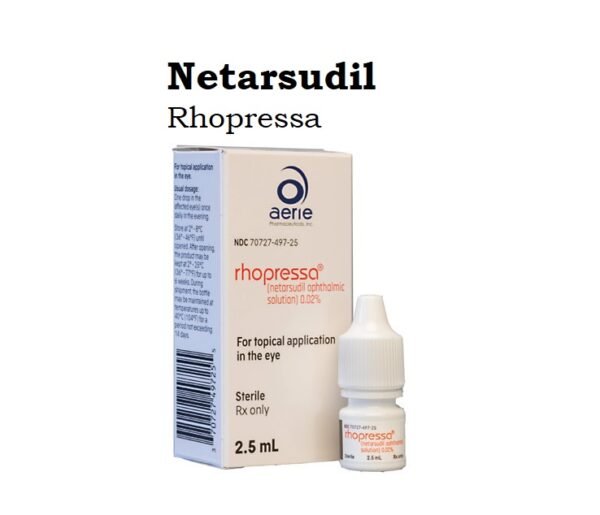Netarsudil is a medication primarily used to treat open-angle glaucoma or ocular hypertension. It works by decreasing the pressure within the eye by increasing the outflow of aqueous humor, the fluid that fills the eye. Netarsudil is typically administered as eye drops and is often used in combination with other glaucoma medications to achieve optimal intraocular pressure control. It's a relatively newer medication and has shown effectiveness in lowering intraocular pressure in clinical trials.
Netarsudil (Rhopressa) is a rho-kinase inhibitor that increases aqueous outflow. It is used as an ophthalmic solution to reduce intraocular pressure.
Netarsudil (Rhopressa) Uses:
- Elevated intraocular pressure (IOP):
- It is indicated to reduce elevated intraocular pressure in patients with ocular hypertension and open-angle glaucoma.
Netarsudil (Rhopressa) Dose in Adults
Netarsudil (Rhopressa) Dose in the treatment of Elevated intraocular pressure:
- When treating high eye pressure, you'd typically put one drop of Netarsudil into the affected eye(s) once a day, usually in the evening.
- Make sure not to use more than one drop in each affected eye each day.
Netarsudil (Rhopressa) Use in Children:
Not indicated.
Netarsudil Pregnancy Risk Category: N (not assigned)
- In studies with animals, no harmful effects were seen when using Netarsudil, even at doses similar to those used in humans.
- When you put the medication in your eye, very little of it gets into your bloodstream.
- If you have to use eye medication while pregnant, it's best to use the smallest amount that works, and your doctor might recommend closing your tear ducts to reduce the chance of the medication getting into your bloodstream and reaching the baby.
Use during breastfeeding:
- It's unclear whether Netarsudil is present in breast milk, but only a tiny amount is absorbed into the body after it's put in the eye.
- The decision to breastfeed while using this medication should take into account the possible risk to the baby from exposure, the benefits of breastfeeding for the baby, and the advantages of treatment for the mother.
- Consulting with your doctor can help weigh these factors and make an informed decision.
Rhopressa Dose in Kidney Disease:
- The manufacturer's instructions don't mention any need to adjust the dosage of Netarsudil in people with kidney problems.
- This is probably because very little of the medication gets into the bloodstream, so it's unlikely to affect the kidneys.
Rhopressa Dose in Liver disease:
- The manufacturer's instructions don't include any recommendations to adjust the dosage of Netarsudil in individuals with liver problems.
- This is likely because the medication is mainly applied to the eye and doesn't enter the bloodstream in significant amounts, so it's unlikely to affect liver function.
Common Side Effects of Netarsudil (Rhopressa):
- Local:
- Application Site Pain
- Ophthalmic:
- Conjunctival Hyperemia
- Conjunctival Hemorrhage
- Corneal Deposits
Less Common Side Effects of Netarsudil (Rhopressa):
- Dermatologic:
- Erythema Of Eyelid
- Local:
- Application Site Erythema
- Ophthalmic:
- Blurred Vision
- Corneal Staining
- Decreased Visual Acuity
- Increased Lacrimation
Contraindications to Netarsudil (Rhopressa):
The manufacturer's instructions don't list any situations where the use of Netarsudil is not recommended, which means there are no specific conditions where it's considered unsafe to use.
Warnings & Precautions
Bacterial Keratitis
- Bacterial keratitis, an infection of the cornea, has been reported due to accidental contamination of multi-use eye drops.
- It highlights the importance of proper hygiene and handling of ophthalmic solutions to prevent such infections.
- Always ensure that eye drop containers are not contaminated, and follow instructions carefully to minimize the risk of bacterial keratitis or any other eye infections.
Monitoring parameters:
- When using Netarsudil to manage intraocular pressure, it's essential to monitor the patient's intraocular pressure regularly.
- This monitoring helps assess the effectiveness of the medication in controlling eye pressure and allows for adjustments in treatment if necessary.
- Regular intraocular pressure measurements can also help identify any fluctuations or trends over time, guiding the overall management of glaucoma or ocular hypertension.
How to administer Netarsudil (Rhopressa)?
- For Eyes Only: Only use this medication in your eyes.
- Combination Use: It's okay to use this with other eye drops to lower eye pressure.
- Time Between Drops: If you're using more than one eye drop, wait at least 5 minutes between each one.
- Remove Contacts: Take out your contact lenses before putting in the eye drops, and wait at least 15 minutes after using them before putting the lenses back in.
- Avoid Contamination: Don't touch the tip of the dropper with your fingers, eyes, eyelids, or anything else to keep it clean.
Mechanism of action of Netarsudil (Rhopressa):
- We're not exactly sure how netarsudil works, but it's thought to lower eye pressure by helping fluid flow better through the eye's mesh-like structure called the trabecular meshwork.
- This meshwork is essential for draining fluid from the eye, and by making it work more efficiently, netarsudil can help reduce intraocular pressure (IOP).
Metabolism:
- Netarsudil is processed in the eye by enzymes called esterases, which convert it into an active form known as AR-13503.
- This active metabolite is what helps the medication work to lower eye pressure effectively.
International Brands of Netarsudil:
- Rhopressa
Netarsudil Brand Names in Pakistan:
No Brands Available in Pakistan.







